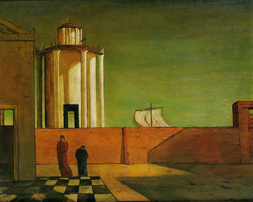The socio-religious context in which ancient tragic-style paintings functioned is still a matter for conjecture. However, whether or not they were simply trompe l’oeil architectural paintings or paintings derived from theatre scenery, or as I and others maintain, symbolic tomb facades, does not in fact alter their iconography. Without exception, every painting contains a reference to a funerary or deification motif. This may take the form of a shrine just visible above a wall as depicted in the House of the Labyrinth, or a funerary urn containing the ashes of a deceased ancestor, such as the one seen in the Room of the Masks (fig.1). The various funerary motifs in both these painting, and many others like them, could simply represent a pictorial connection with the rites of the dead or deceased ancestor spirits. However, the way in which these paintings both affirm and deny pictorial space suggests a more complex interpretation. The motif that potently renders the simultaneous affirmation and denial of pictorial space is the trompe l’oeil image of the wall. It is the defining feature of the tragic-style and also, quite literally, hundreds of De Chirico’s paintings (fig.2-3).
In the ancient tragic-style, the significance of the recurring wall motif lies in the fact that it appears to create a physical barrier, which is psychologically enhanced by being positioned so as to appear to lie on a plane coincidental with that of the real wall on which it has been painted. This has the effect of making the real wall disappear and in so doing the illusion becomes the reality. Invariably, the top of the pictorial wall stops short of the top of the actual wall. In this gap architectural forms, such as the peristyle and the tholos, create a spatial illusion beyond the pictorial wall and, by implication, the actual wall. This is further emphasised by atmospheric perspective, which reinforces the sense of a space beyond both the pictorial and the actual wall. This sophisticated merger of real and virtual worlds is exemplified by the tholos wall-painting in the Corinthian oecus of the House of the Labyrinth and the Boscoreale cubiculum M painting, both cited earlier.
The relationship between linear and atmospheric perspective in paintings such as these is more poetic than logical. As is De Chirico’s equally poetic use of multiple vanishing points and dislocated shadows, which conjoin to create the enigmatic atmosphere that permeates so many of his paintings. In the Labyrinth painting, the illusionistic space beyond the wall is yet further emphasised by the careful alignment of the columns in the room itself. The various pictorial planes, both real and illusionary, unfold in such a natural way we are led, almost imperceptibly, from the room itself into the world beyond the wall. Here in lies the major paradox contained in our ancient model. Linear perspective is used to create a sense of deep space, which has the effect of enticing us psychologically to enter the picture plane. However, when we try to do so we are prevented by walls or closed door motifs, such as those depicted in the triclinium of the Villa Publius Fannius Synistor (fig.4) The space beyond the wall is unattainable – it is sacrosanct. This is evidenced by the bricked-up entrance in the Labyrinth painting and the demonic masks on either side of the door in the Synistor painting, both of which reinforce the unattainable sanctity of the space beyond the door.
 2
2